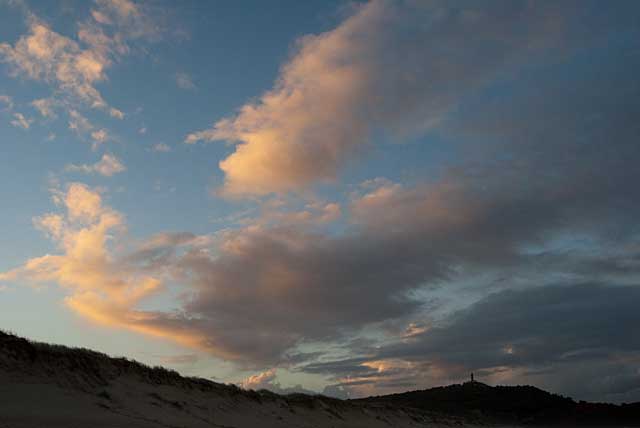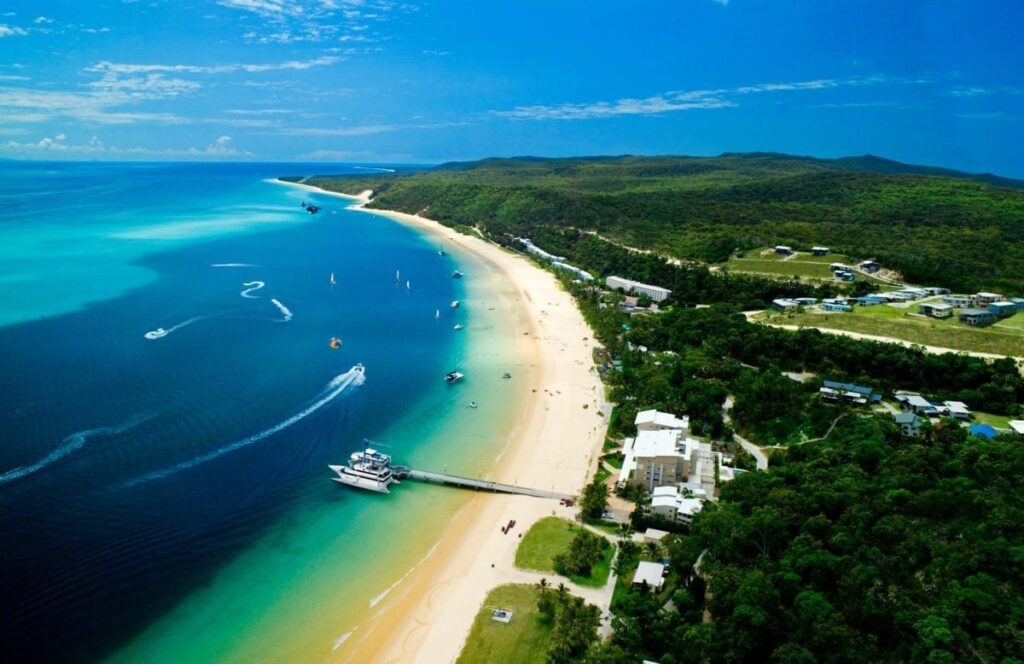Moreton Island

Moreton Island once had people hunted the waters around Morton Island at least 2,000 years ago, and the island is still home to more than 300 Aboriginal cultural sites. Captain James Cook first sailed the area in 1770, naming the bay where Morton Island is located after James Douglas, the Earl of Morton. A clerical error added an extra “e” and the bay and the island are now forever known as “Moreton”. Since then, the island has been home to a pilot station, whaling station and major wartime coastal defence bases, none currently in use. Still relatively untouched, Morton Island’s 192,600 hectares is up to 98% National Park, providing a true refuge for the island’s distinctive flora and fauna, both on land, sea, and air, as well as the diverse terrains on the island, including freshwater lakes, coastal sand dunes (some of the steepest in the world), and wetlands.

Morton Island can be accessed via three ferries. The Amity Trader plies the route between Stradbroke Island and the southern fishing village of Kooringal while the MICAT Ferry operates between the Port of Brisbane and the Tangalooma Wrecks on the island’s west coast. Those who have booked a day-cruise option at the Tangalooma Resort or who are staying overnight at the resort can take the pedestrian-only resort ferry leaving from the Holt Street Wharf in Pinkenba (Brisbane River Northsides). Built on the site of Queensland’s only whaling station between 1952-1962 and harvesting up to 600 migrating humpback whales per season, the Tangalooma Island Resort is now known for its
animal conservation efforts. Best known among these is the popular wild dolphin feeding programme.
Every sunset, visitors can watch from the jetty or wade into the water and hand-feed up to a dozen wild bottle-nose dolphins who come to the shallows in a ritual that started more than three decades ago. A Dolphin Care Team monitors the process, ensuring the dolphins are only fed a maxiumum of 20% of their daily food requirement so that they remain wild and independent Being in the water with these friendly, inquisitive mammals is a once-in-a-lifetime experience that is sure to delight young and old. The resort’s Eco Center also organizes feedings for kookaburras and pelicans as well as guided bush walks and educational talks about the old whaling station and local marine life.

On land, more than 40 reptile species call Morenton Island home, including bearded dragons and blue-tongued lizards, while the surrounding sea sees sharks, Green and Loggerhead turtles (which come ashore to next between November and February), more than 1,000 dugongs, and dolphins. Even more spectacular is the Humpback Whale migration from June to November when upwards of 15,000 whales make their way past Moreton Island.
Even if not staying at the Tangalooma Island Resort, the township itself is worth a visit. Climb up the dunes for sweeping views over the 8km-long Tangalooma Beach, home to the famed Tangalooma Wrecks, 15 vessels deliberately sunk in the 1960’s to form a man-made breakwall. The neat line of rusted brown hulls of old dredges and barges (with the tops ct off for safer swimming) rising from crystal-clear blue waters is certainly a striking sight. Bring your own snorkeling gear and swim out to enjoy the corals and tropical marine life around the wrecks or rent a transparent kayak (lit up at night) and glide over the water.
Home to massive wind-swept sand dunes, sit or lay down on a piece of waxed Masonite and hang on for dear life as you “sand toboggan” down the steep dunes at speeds of up to 60 kph! For something equially blood-pumping but a good deal slower, a hike up the sand dunes may be in order. Allot an hour and a half for the 4km-long desert circuit which takes you along the beach and up to the sand boarding hill with opportunities to spot desert wildlife.

To see the majority of the island’s highlights, you’ll need to hug the coast north from Tangalooma. A 25-minute drive will take you to the village of Cowan, once home to a pilot station and military camps. Nowadays, it’s best known for the Curtin Artificial Reef comprised of 32 ships and other man-made structures sunk here since the late 1960’s. This submerged marine playround is popular among drivers for both the wreck and the plentiful ocean life including turtles, sharks, stingrays and giant grouper at depths from 12 to 28 meters.
The Western Coastline, you’hit the charming fishing village of Bulwer, with its 8km-long beach boasting calm, clear seas and great sunset views over moreton Bay. Bulwer is also ideal for swimming and Bulwer Wrecks (three ships scuttled in the 1930s in shallow 1-2m-deep water) and the Car Bodies (a sunken old and VW Beetle) at the south end of town. If you continue north you’ll pass the dynamic beaches of Health Island and Yellow Patch. There’s even surfing to be had at North point and Boulders Beach. At the northern tip of Moreton island, you’ll also find the Champagne Pools, created as waves roll over a natural break wall of volcanic rock and sandstone. Wade into the sandy pools and allow the frothy water to pour over you like a glass of bubly, making for great photos!

Just around the corner, you’ll a series of four small beaches created by a ridge of bedrock. Make your way through the rocks to the best known and most accessible, Honeymoon Bay, dramatically backed by rocky cliffs. While beautiful to look at, look out for rips and big waves. This part of the island is also known for superb diving around the only true coral reef, Flinders Reef, a gorgeous collection of hard and soft coral along with teeming marine life including turtles, rays and woobegong sharks. Divers may also be lucky enough to hear a hauntingly beautiful whale song or two during migration season.
Another must-see attraction around Cape Moreton is the historic 23m-high lighthouse, Queensland’s very first. Built in 1857 by tradesmen and convicts to guide ships navigating the treacherou entrance to Moreton Bay on their way to Brisbane, the fully-functioning, fully-automatic red-striped lighthouse now provides a superb vantage point from which to spot dolphins, whales, sharks, and dugongs. Don’t miss the excellent museum inside the old caretaker’s cottage for insight into the history of the lighthouse and Moreton island. Rounding the cape and coming back down on the island’s eastern coast, you’ll hit a pair of freshwater lakes, both excellent for a refreshing swim. The trea tree oil-infused Blue lagoon is the larger and more popular of the two with its surrounding wild flowers and birdwatching opportunities, whereas Honeyeater Lake is home to a large variety of birds (including the lake’s namesake honeyeater which comes to feast on the flower spikes and fruiting cones of the banksia flower).
At this point, fitness enthusiasts might want to leave your 4wd behind and undertake the 6-hour, 16km-long return hike along the old telegraph Road track that leads from the Bulwer – Blue Lagoon Road on down to Mount Tempest. Add in another 2 hours to make the difficult hike up what is quite possibly the world’s highest coastal sand dune and be rewarded with uninterrupted views in every direction from 285 meters above sea level, sweeping across the Sunshine Coast on down to Brisbane and the Gold Coast on a clear day.

Campabout Oz 4WD Hire has a national wide network of agencies which are strategically positioned in close proximity to all famous tourism destination and hot spots, as well as major regional and capital cities throughout Australia so you are never far from a pick up point or friendly service to make your Road trip a memorable one.
Campabout Oz 4WD Hire is renowned for meticulously maintained vehicles and quality service. Our fleet is constantly being updated to ensure you enjoy the best in comfort and safety making it the ideal choice for your next self-drive adventure. 4WD Tourism is one of the best ways to see the sights of Australia and it offers you the freedom & flexibility to discover the outdoors at your own pace. For your Gibb River Road 4WD Hire adventure please contact us on + 61 8 9858 9126 or email us on info@campaboutoz.com.au or visit us at www.campaboutoz.com.au

No comment yet, add your voice below!